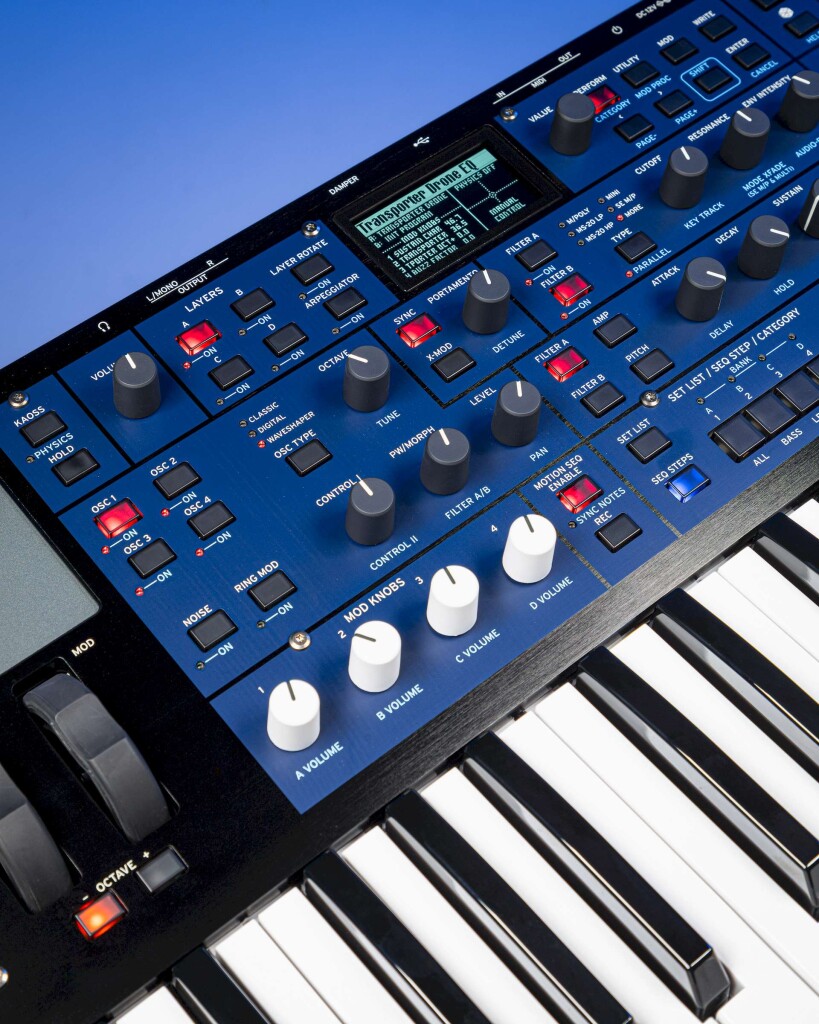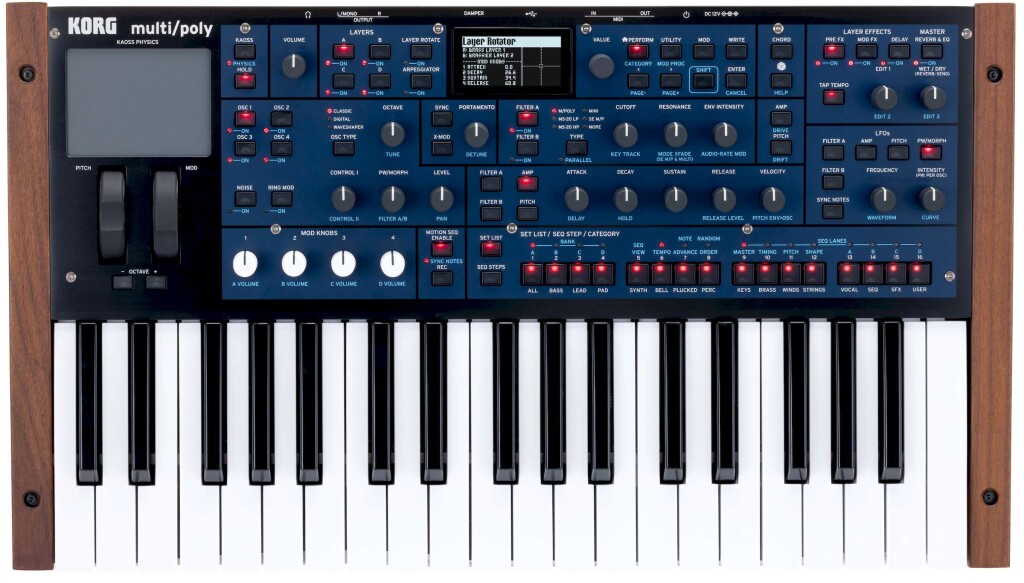KORG’s new multi/poly is an analog modeling synth, not an analog remake of the Mono/Poly. But it’s the debut of a new platform for the company – and the digital approach could mean a balance of authentic sound with some much-needed new ideas. It’s really a Mono/Poly crossed with some of the best of recent KORG digital synths and modular. And there’s even a dose of KAOSS.
KORG has had some success with all-analog remakes, with the MS-20, ARP Odyssey, and ARP 2600 M. But that approach isn’t without downsides. I’m curious to talk to KORG about what informed the decision here. But paradoxically, digital modeling in 2024 can match and sometimes exceed what’s possible with currently available analog components. Some analog parts aren’t available (in their original or equivalent form), or behave in ways you can’t recreate in modern analog hardware. (You can’t include variations or aging in the best case.)
And then there’s cost, size, and power consumption. Digital models sip electricity and give you more flexibility.
If we had the same conversation 15 years ago, I wouldn’t be able to be as confident in this argument. The reality is that greater computational power (at lower cost and lower heat consumption) now allows the models to reproduce the idiosyncracies and nonlinearities of their source material in a way that wasn’t possible before. There’s also been a lot of human work as hardware has evolved and shared techniques for better modeling the behaviors of filters, envelopes, and so on. As with other digital processes, you also have new choices that weren’t possible before – parameterized control over those models or swapping components from different hardware.

In the case of multi/poly, KORG seems to have embraced digital as a way of riffing on the mono/poly – modeling the stuff we love about the original but adding new ideas. And given the number of clones we have now, maybe that’s the best reason to go digital. The multi/poly promises to be more than just a history lesson. It’s amazing how many authentic recreations we’ve had, but there’s room for something authentic that’s also innovative.
That could be relevant beyond just this instrument, too. KORG says the multi/poly is the debut of a next-generation analog modeling system. I was missing that from rival Roland – after what was a great start with ACB (Analog Circuit Behavior). Previous KORG hardware was based on the same ARM compute unit as the Raspberry Pi – so this is likely a newer generation of that. After generations of expensive hardware based on custom, costly ASIC chips, these solutions allow far easier development and iteration, letting music engineers focus on the actual instrument design. (Ableton’s Move uses something similar internally.)
So let’s look at what KORG is promising on both the vintage and new sides of the coin:
KORG says the multi/poly is the debut of a next-generation analog modeling system.
Something old, something modeled
Look, the Mono/Poly is just one of my favorite instruments ever – is stacked oscillators, its ingenious round-robin oscillator triggering and all the musical possibilities that opens up, all the x-mod and sync features, its sound, its personality. This could be a top desert island synth.
And it seems everything is there, with extra options:
- Virtual Voice Cards for each voice, which KORG says are fully modeled across oscillators, filters, envelopes, LFOs, and portamento, with all the analog details and – crucially – modeling the ways in which each individual voice can vary slightly from the other. (That might well work less effectively in analog components, folks, because ironically modern component quality is higher.)
- Precise, modeled envelopes for not just the Mono/Poly, but also other devices – so you could hear a Mono/Poly with the VCA behavior of an MS-20, an ARP Odyssey, or certain unnamed rival makers of the same era rhyming with rogue and, uh, mequential.
- Single/dual waveform options.
- Dual-modeled filters, which you can also swap with models of the ladder filter, Prophet (uh, sorry, I named it), MS-20, SE, and others in various varieties.
- Layers and Layer rotate for the “cycling through oscillators with variations” that made the original so magical.
As KORG explains:
Just like in an analog synth, voice cards also continue to play even if you’re not hearing them. Envelopes keep evolving, so that if you play a pad with a long release time, newly played notes “catch” the envelope at its current level instead of restarting from zero. Oscillators and LFOs maintain their phase, and resonance continues to ring. Each oscillator’s pitch can also drift slightly over time, modeling the slight pitch instabilities found in analog hardware.
And it’s just generally a useful synth to have, with ring mod and noise as options.
More on that soon, but there’s more…

Something new
Holy crap, this is more than just a Mono/Poly – and it even builds on recent recreations like the KORG modwave.
- Uh, up to 60 voices?
- 5500 modulation destinations?!
- Multi-effects onboard: pre and mod FX (practically a full stereo pedalboard in there), multimode delay, reverb, EQ, etc.
- X-mod and sync are expanded in their capabilities – like a more Mono/Polyish Mono/Poly
- Digital oscillator with up to 64-step wavetables, like a vintage hybrid. There are 200 factory wavetables onboard, and you can import your own or use modwave wavetables.
- 30+ modifiers for the digital oscillator, morphing, and more.
- It’s got a waveshaper/wavefolder… so it is also a West Coast synth
- The aforementioned additional filters / Multi Filter are in there, too – and you can use all of these filters in series or in parallel.
- Four loopable DAHDSR envelopes, five LFOs, and six Mod Processors…
- Motion Sequencing 2.0 capabilities, per program, which KORG says are an evolution of the wavestate’s various parameter sequencing.
- Layer up to four programs into a Performance.
- Kaoss Physics which gives you all kinds of physics simulation on the built-in KAOSS Pad – bouncing balls and such.
And atop the sound features, you also get set lists and Smooth Sound Transitions.

So let’s get this straight. That makes it sound like a stage piano/workstation. The physics and X/Y expression are straight out of an advanced KAOSS Pad. The sequencing is an expansion of the wavestate. The wavetable oscillator is descended from the modwave.
But despite all of this, it still looks friendly like a Mono/Poly and can model the way a Mono/Poly sounds and behaves. Honestly, while everyone complains about it being “digital,” the only real tradeoff I see is that you don’t quite get the iconic control layout of the Mono/Poly – though at least you do still get quite a lot of control with push-button switching (and could configure the mod knobs in a way that keeps it hands-on). If someone told you you had to choose one device and it couldn’t be a modular, this single instrument does a lot of what makes KORG KORG.
If someone told you you had to choose one device and it couldn’t be a modular, this single instrument does a lot of what makes KORG KORG.
Normally, if you do something like this, you’re supposed to make it insanely expensive and call it a flagship and … parts of it should definitely not work properly. But yes, it is 2024, so we do have a ton of computing power for our keyboards.
And yeah – it’s $899. (Preorders for now.)
If you buy something from a CDM link, we may earn a commission.
Multi/Poly Analog Modeling Keyboard Synthesizer @ Perfect Circuit
KORG Multi/Poly Virtual Analog Synthesizer @ Guitar Center
Korg Multi/Poly Analog Modeling Synthesizer @ Sweetwater
Oh, uh, if someone wants to buy me this for some reason, I wouldn’t say no:
Vintage Mono/Poly at Guitar Center
So I say, why not? Like you know, create digital music or something…

Watch this space.
Meanwhile, watch these videos:
Specs:
System:
Keyboard: 37 key semi-weighted action (velocity and release-velocity sensitive)
Maximum Polyphony: 60 voices (varies depending on settings)
Sound generating system: Analog modeling synthesisModulation:
Controllers: Mod Wheel, Pitch Wheel, Kaoss Physics, 4x Mod Knobs
Other Sources: 4x Envelopes, 5x LFOs, 8x Mod Processors, 3x Key Track, Seq Lanes A-D, Step Pulse, Step Pitch, Motion Seq On, Kaoss (X, Y, Distance, Angle, X+, X-, Y+, and Y-), Tempo, Program/Performance Note Count, Program/Performance Voice Count, Random (1+, 2+, 3 +/-, and 4 +/-), Constant Max, Poly Legato, Velocity, Exponential Velocity, Release Velocity, Gate, Gate+Damper, Note-On Trigger, Note-On Trigger+Damper, Note Number, Aftertouch and Poly Aftertouch (external MIDI only), Pitch Bend (normal, +, and -), MIDI CCs +/-, MIDI CCs +
Destinations: Most parameters can be modulated, with over 5,500 potential modulation targets per Performance.Effects:
Pre FX: Decimator, Graphic EQ, Guitar Amp, Modern Compressor, Parametric EQ, Red Compressor, Ring Modulator, Tremolo, Wave Shaper, Vintage Distortion
Mod FX: Black Chorus/Flanger, Black Phase, CX-3 Vibrato Chorus, EP Chorus, Harmonic Chorus, Modern Chorus, Modern Phaser, Orange Phase, Polysix Ensemble, Small Phase, Talking Modulator, Vintage Chorus, Vintage Flanger, Vintage/Custom Wah, Vox Wah, CX-3 Rotary Speaker
Delay: L/C/R Delay, Multiband Mod Delay, Reverse Delay, Stereo/Cross Delay, Tape Echo
Master Reverb: Early Reflections, Overb
Master EQ: 4-band parametric EQGeneral:
Inputs/outputs:
Headphone (6.3 mm stereo phone jack), OUTPUT L/MONO and R (impedance-balanced 6.3 mm TRS phone jacks), DAMPER (6.3 mm phone jack, half-damper not supported), MIDI IN and OUT connectors, USB B portPower supply: AC adapter (DC12V, 2500mA)
Power consumption: 5 W
Dimensions (W × D × H): 22.28″ × 12.56″ × 3.66″ (566 x 319 x 93 mm)
Weight: 7.72 lb / 3.5 kgIncluded items: AC adapter, Precautions, Quick Start Guide
Accessories (sold separately): DS-1H damper pedal, PS-1 pedal switch, PS-3 pedal switch